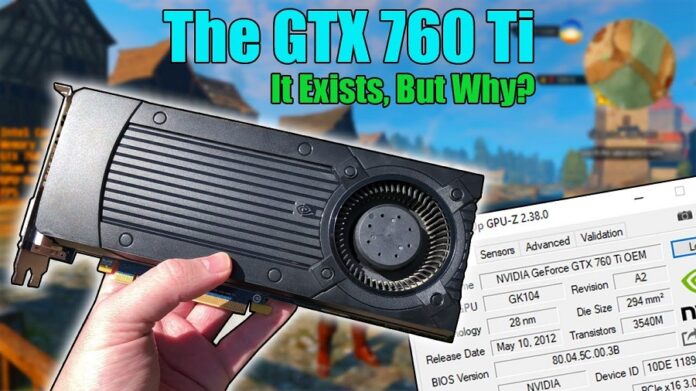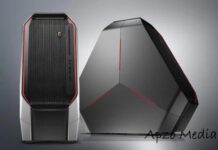The recently released Nvidia GeForce GTX 760 is the next addition to NVIDIA’s GeForce GTX 700 series. It is based on the same GK104 GPU. This was used in the GeForce GTX 680 from a year ago and a few more GTX 600 series cards.
However, the GTX 760 targets a different market. And this makes its debut at a significantly more affordable price point than its predecessor. Read this article to learn more about its specification and benchmarks.
Nvidia GeForce GTX 760 Overview
Based on the Kepler GK104 processor, the NVIDIA GeForce GTX 760 is a mid-range computer graphics card. It is much faster than the laptop-specific mobile GTX 760M. The core can be clocked between 980 and 1033 MHz. This was based on the chipset temperature and energy consumption (or even higher).
The 760’s GDDR5 graphics memory operates at a 3000 MHz speed (6000 MHz effective). On average, the GTX 760 performs similarly to the Nvidia GTX 660, 770, and 680, as well as the AMD Radeon R9 270X and R9 280.
Nvidia GeForce GTX 760 Specification Details
The GeForce GTX 760, according to them. It is built on the same Kepler series GK104 GPU as the GTX 770 and GTX 660 Ti. In 3D applications, its base GPU clock rate is 66 MHz lower than the GTX 770 and 65 MHz. Higher than the GTX 660 Ti. The Nvidia GeForce GTX 760 thus has 384 (or 25%).
Less unified shader processors and 192 (14.3%) fewer unified shader processors than the GTX 760 and GTX 660 Ti, respectively. It also has a lower fraction of texture-mapping units. The GeForce GTX 760 has 32 raster operators, the same as the GTX 770. The new card’s main selling point is its increased memory capacity.
The new card’s main selling point is its larger memory bus. This is now 256 bits wide relative to the GTX 760’s 192-bit bus. The GTX 760 has a 33.4% larger memory bandwidth than the GTX 660 Ti. Therefore we may expect the former to outperform the latter at high resolutions or even when full-screen antialiasing is activated.
Concept and Usability
The GeForce GTX 760 appears to be simpler than the GTX 780 or GTX 770, approximating the GeForce GTX 650 Ti Boost. The cooling system’s moulded plastic housing spans the entire face edge of the card. The length of the card is 242 mm.
The Nvidia GeForce GTX 760 has three video outputs: dual-link DVI-I/D, HDMI 1.4a, and DisplayPort 1.2. In terms of video interfaces the GTX 760 is identical to the top-end models in Nvidia’s new series. In addition, it contains two MIO ports (for connecting two, three, or even 4 graphics cards in SLI mode) and 2 6-pin power connectors in their standard locations.
According to the standards, the GeForce GTX 760 uses no more than 170 watts of power, which is 60 watts less than the GTX 770 and 20 watts more than the GTX 660 Ti, both of which have two 6-pin power connectors.
It would have been unusual for Nvidia to create an entirely new PCB for a video card with such high specifications as the GeForce GTX 760. As a result, the new model is built on the PCB from of the GeForce GTX 660 Ti. The power supply is positioned in the device’s front and is cooled by a huge aluminium heat sink.
The GPU device is merely 294 square mm in size and contains 3540 million transistors. In 3D applications, the base GPU clock rate is 980 MHz. It can be officially pushed to 1033 MHz, however in our tests with maximum power and heat settings, the GPU clock rate reached 1137 MHz, which is 100 MHz more than the specified level. The impact of GPU Boost 2.0 capability is evident here.
Performance Benchmarks
In Civilization V’s “Late Game View” benchmark test, the Nvidia GeForce GTX 760 behind the newer Nvidia GTX 770 by a single frame, at 87 fps vs. 89 fps. The AMD Radeon 7950 also achieved 89 frames per second, putting all three systems in a virtual tie. In Shogun 2: Total War, however, the GTX 760 achieved 39 fps.
It is slightly ahead of the more expensive AMD Radeon 7950 37.5 fps but far below the Nvidia GTX 770 50fps. AMD edged ahead in Metro 2033 and its follow up, Metro: Last Light. The GTX 760’s Metro 2033 and Metro Last Light scores of 29 fps and 26 fps, respectively, trailed the AMD Radeon 7950 32 fps and 27 fps. The GTX 770 achieved 33 fps in both instances.
But you’ll want to reduce video details on all of these cards if you want a smooth frame rate. In BioShock Infinite, the AMD Radeon 7950 outperformed the Nvidia GTX 660 (63 fps to 57 fps), but the Nvidia GTX 770 outperformed both (71 fps). In DiRT 3, the AMD Radeon 7950 scored 92 fps, while the GTX 760 scored 84 fps.
The AMD Radeon 7950 also outperformed the GTX 760 in the game’s built-in benchmark test, scoring 29 fps versus 34.5 fps for the AMD system. Again, the Nvidia GTX 770 comes out on top, at 44 fps, as we’d probably expect the pricing.
In Sniper Elite V2, the GeForce GTX 760 shines. It is 13-17% faster than the GeForce GTX 660 Ti at stock settings, meaning that it will only catch up when overclocked. The GeForce GTX 760 then outperforms the Radeon HD 7950 at overclocked settings. Now, the overclocked GeForce GTX 760 is as powerful as the standard GeForce GTX 670 while being the most affordable offering.
Conclusion
Despite having an inferior graphics engine, the Nvidia GeForce GTX 760 surpasses the GeForce GTX 660 Ti because to its 256-bit memory. Faster GPU clock speed and GPU Boost 2.0 capabilities. As a result, the GeForce GTX 760 has a 14% advantage over the GTX 660 Ti on average.
We also noticed that the newcomer led a video card from a different category but from the prior generation – GeForce GTX 670 – by only a small margin (about 8%) which can be easily eradicated by just overclocking the newer GeForce GTX 760. Even in overclocked mode, our hero of the day cannot keep up with the GTX 770.
Must Read : Surveyor Near Me: The Important Factors Of This Career



































































